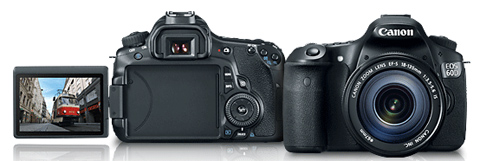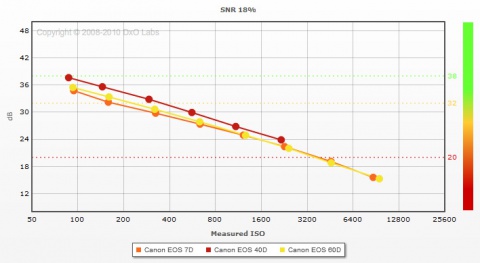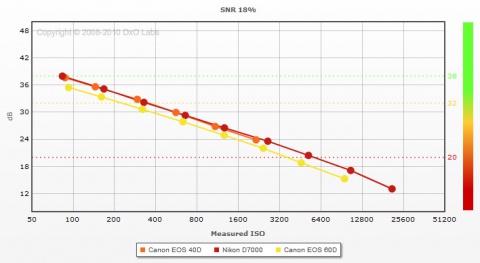Canon EOS 60D Review: Noisier than 40D

Canon EOS 60D
I’m going to be very short with my review of the Canon EOS 60D: IT SUCKS.
On second thought, let me elaborate on that.
The Canon EOS 60D is a step backwards in the xxD series on almost all levels. If you own a 20D, 30D, 40D or, heaven forbid, a 50D, then by getting a 60D you won’t really be upgrading. Well, maybe if you own a 20D and 30D you could consider it an upgrade but only because those cameras are now very old and outdated. But in the case of the 40D it is definitely a downgrade, and in the case of the 50D everything is a downgrade except for the image quality, which will be better on the 60D (but keep in mind that the image quality on the 50D was terrible compared to the 40D).
Why am I saying this? First because the imaging sensor used in the 60D is the same sensor that is used in the 7D. I have said a lot about the inferior image quality that the sensor in the 7D produces compared to the 40D. For details on this, please read my review of the EOS 7D. The same things I said there about image quality on the 7D apply to the 60D as well because both use the same 18MP sensor. Basically the images from the 60D will also contain more noise compared to images taken on the 40D at ISO values lower than ISO 3200. So if image quality is important to you, then the 60D is not the best choice right now, especially not when you also consider the competition, namely the Nikon D7000. A comparison between the EOS 7D, 60D and 40D models can be seen on DXOMark if you follow this link.

In the graph above taken from a comparison on DXOMark you can clearly see how the performance of the 7D and 60D are very similar, and how they both perform worse than the 40D with regard to noise levels on screen.
If you compare the 60D and 40D to the Nikon D7000 on DXOMark (follow this link) you get the results below:

In the graph above taken from a comparison on DXOMark you can see that the image quality on the Nikon D7000 comes close to the Canon EOS 40D as far as on screen noise is concerned. This is a great achievement for Nikon, as the D7000 has a 16MP sensor while the 40D has a 10MP sensor. The 60D performs worse than the new Nikon D7000 and worse than even the 3 year old 40D. This is a shame for Canon.
Apart from the inferior image quality, the 60D is also a step backwards in the xxD series when you consider build quality. Older models like the 40D and 50D had a strong magnesium-alloy body whereas the 60D has a body that is made up of aluminum and plastic, putting it more in the entry level Digital Rebel (xxxD) category. Essentially the 60D became a Digital Rebel that’s a little more advanced than the EOS 550D. Perhaps Canon didn’t want the 60D to compete too much with the 7D, and I’m sure that in true Canon style they also wanted to save a couple of bucks on build quality so they could make even more money off of us. But the result is not worth the money they are asking for it in my opinion ($1100), and especially not when Nikon came out with a body in the same category that DOES have a magnesium-alloy body, namely the Nikon D7000 costing $1200. Canon is now slowly building up a history of wanting to sell products with inferior specs for a lot more than they are worth. In a similar way they priced the 5D Mark II at $2700 with a ridiculously underperforming autofocus system, while Nikon had their D700 also priced around $2700 with an advanced pro-level autofocus system. This time Nikon is one-upping Canon again with their D7000, as they have consistently done since the release of the D3.
As if scaling back the build quality on the 60D wasn’t enough Canon also removed some features such as autofocus micro-adjustment for lenses, an essential feature that was missing on the 40D, introduced with the 50D, and now taken away again with the 60D. When you’re familiar with all the autofocus issues with Canon cameras and lenses, you realize even more how important such a feature is on a camera. You only have to do a simple search on Google to find thousands of cases where people are complaining about their (often even brand new) lenses having front or back focus issues. In such a case the autofocus micro-adjustment feature is very handy to try and correct the issues yourself, or to fine-tune autofocus on your camera in combination with the lenses you own. But somehow Canon had to remove this from the 60D, I suspect to make it even more inferior to the 7D. But guess what? Nikon put this feature in their D7000, again one-upping Canon’s 60D.
And so it appears again that engineers and marketing people at Nikon have a much, much, MUCH better understanding of what photographers really want in a camera, and what combination of features make sense. While Nikon went a couple of steps forward with their D7000 compared to the D90, Canon actually went backwards on exactly the same steps from the 40D to the 60D. Nikon even equipped the $1200 costing D7000 with an advanced 39-point autofocus system. It may not be as good as the 51-point AF system in the D300s, for example, but it won’t surprise me one bit when it turns out to be A LOT better than the old 9-point AF system in the 60D that Canon has now been using ever since the 40D (!!!). It seems that Canon purposely holds back every time while Nikon is constantly innovating and pushing the envelope with each new DSLR model they release. It is incredible what Nikon has achieved with the D7000. The D7000 is so good that it can easily compete with the Canon EOS 7D ($1800 price range). Even the image quality of the D7000 is better compared to the EOS 60D and EOS 7D. If you look at the features of the D7000 and the 60D side by side, it becomes very clear that the D7000 is vastly more superior than the 60D while costing just $100 more. Some of the features on the D7000 include dual memory card slots, autofocus micro-adjustments, continuous AF in movie mode, magnesium-alloy body with weather sealing, 39-point autofocus system with 3D matrix metering and of course better image quality – all for almost the same price as the 60D.
So as far as I’m concerned, the 60D is another disappointment in the line of very disappointing camera bodies Canon has released in the last 4 years. Clearly Canon is trying to sell us inferior technology at a premium price, while the competition has a lot more to offer at the same price levels. If you’re looking for a DSLR in the $1000-$1200 price range, the Nikon D7000 is currently the best there is on the market. The D7000 is a better choice compared to the Canon 7D, 60D, 50D, 40D, the Nikon D90 and the Nikon D300(s). Depending on your needs, the D7000 is also a better choice compared to the Canon EOS 5D Mark II (only if you really need 21MP and full-frame) and the Nikon D700 (only if you need full-frame).

Comments
There are 10 responses. Follow any responses to this post through its comments RSS feed. You can leave a response, or trackback from your own site.